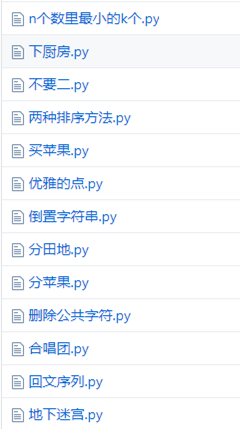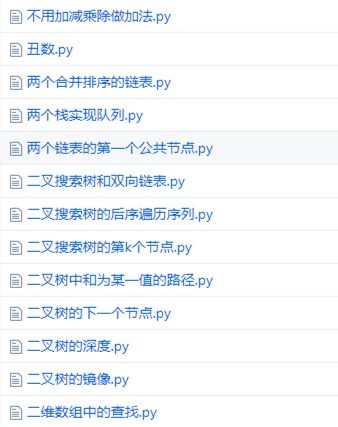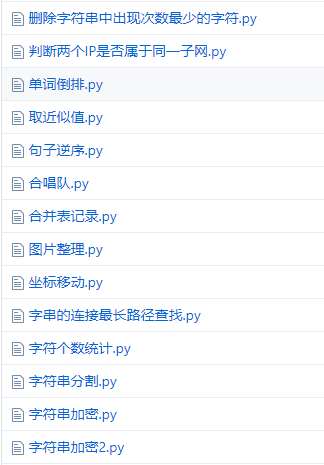With the spring recruit approaching, it is always of great benefit to prospective graduates looking for a job or programmers who want to improve their own algorithms, internal mental skills and python programming ability in the workplace. Today, red stone found a good resource: a collection of interview questions implemented in Python!
This resource is called: Interview code practice Python! It contains hundreds of algorithmic interview questions, and all the answers are written in Python. With questions and answers, isn't it fast to learn~
Well, don't say much, just put the GitHub address of this interview collection:
https://github.com/leeguandong/Interview-code-practice-python
This project resource contains five real questions in total, namely: 2017 school recruitment real question, sword finger offer, Huawei machine test, machine test question and straight through BAT algorithm question.

Next, let's take a look at the specific contents.
1. 2017 school enrollment
This part contains 37 real school recruitment questions in 2017.

Each topic is equipped with a corresponding Python implementation. For example, let's take an interesting example: a restaurant py
# Select n batches from m batches of guests and set n tables
n, m = [int(x) for x in input().split()]
# Maximum number of people per table
table = [int(x) for x in input().split()]
# Respectively represent the number of guests in the i batch and the estimated consumption amount
cus = [[int(x) for x in input().split()] for i in range(m)]
# Arrange the tables according to the number of people you can hold from small to large
table.sort()
# Sort by the number of customers in each batch from small to large
cus = sorted(cus, key=lambda x: x[0])
# Total amount
money = 0
for i in range(n):
# Hold the i th acceptable customer batch j
temp = []
# Note that the length of cus is updated in the range
for j in range(len(cus)):
if cus[j][0] > table[i]:
break
temp.append(cus[j])
# Sort by consumption amount
temp = sorted(temp, key=lambda x: x[1])
if temp:
money += temp[-1][1]
# This group of guests are already seated
cus.remove()
print(money)2. Sword finger offer
This part contains 68 sword finger real questions.

Look at the example: abnormal frog jumping py
'''
Title: a frog can jump up 1 step or 2 steps at a time... It can also jump up n Level. Ask the frog to jump on one n How many jumping methods are there in all
'''
'''
because n Steps, the first step is n Three jump methods: jump level 1, jump Level 2 and jump to n level
Skip level 1, leaving n-1 Level, the remaining jump method is f(n-1)
Skip Level 2, leaving n-2 Level, the remaining jump method is f(n-2)
therefore f(n)=f(n-1)+f(n-2)+...+f(1)
because f(n-1)=f(n-2)+f(n-3)+...+f(1)
therefore f(n)=2*f(n-1)
Then solve the sum of this infinite series. The correct answer should be: jump at least one at a time and jump at most n Yes, there are f(n)=2n-1 Seed jump method
29ms
5632k
'''
# -*- coding:utf-8 -*-
class Solution:
def jumpFloorII(self, number):
# write code here
return 2**(number-1)3. Huawei machine test
This section contains 41 Huawei computer test questions.

See example: password verification qualification program py
'''
1.Length exceeds 8 bits
2.Include upper and lower case letters.number.Other symbols,At least three of the above four
3.Substrings with the same length exceeding 2 cannot be repeated
explain:Substring longer than 2
'''
# import re, sys
#
# for i in sys.stdin.readlines():
# print("OK" if len(i.strip()) > 8 and sum(
# [1 if re.search(r"[A-Z]", i.strip()) else 0, 1 if re.search(r"[a-z]", i.strip()) else 0,
# 1 if re.search(r"[0-9]", i.strip()) else 0, 1 if re.search(r"[^0-9a-zA-Z]", i.strip()) else 0]) > 2 and sum(
# map(lambda c: i.strip().count(i.strip()[c:c + 3]) > 1, range(1, len(i.strip()) - 3))) == 0 else "NG")
# If you think a little, you only need to judge whether the substring with length of 3 appears. Because if the substring length is 4, the substring length of 3 must be included. At the same time, it should be noted that,
# The substring in this question refers to the overlapping of some substrings,
# For example, Qw11111*ed cannot pass. Another thing to note is that when judging the substring, you only need to judge len(str)-3.
import sys
try:
# Case, letters,
def panchar(sss):
standard = [0] * 4
for i in sss:
# print(i)
# 0
# 2
# 1
# A
# b
# print(len(sss))
# number
if i.isdigit():
standard[0] = 1
# print(i.isdigit())
# a lowercase letter
if i.islower():
standard[1] = 1
# Capitalize
if i.isupper():
standard[2] = 1
# It's all letters, numbers, spaces
if not i.isalpha() and not i.isdigit() and not i.isspace():
standard[3] = 1
if sum(standard) >= 3:
return False
return True
# A string with the same length exceeding 2 cannot be repeated
def zichuan(sss):
for i in range(len(sss) - 3):
zichuan_1 = sss[i: i + 3]
zichuan_2 = sss[i + 1::]
if zichuan_1 in zichuan_2:
return True
return False
result = []
while True:
line = sys.stdin.readline().strip()
if line == '':
break
if len(line) <= 8:
result.append('NG')
# Upper and lower case letters Number Other symbols
elif panchar(line):
result.append('NG')
elif zichuan(line):
result.append('NG')
else:
result.append('OK')
for i in result:
print(i)
except:
pass
# # Loop input, try catch
# while True:
# try:
# x = input().split()
#
#
# except:
# pass4. Machine test questions
This section contains 3 machine test questions.

See example: sorting py
# https://blog.csdn.net/u012193416/article/details/78790448
# # Bubble sorting
# # Time complexity O(n**2) space complexity O(1)
# x = [int(i) for i in input().split(',')]
#
# # print(x)
#
# def mpsort(x):
# n = len(x)
# # print(n)
# for i in range(n - 1):
# for j in range(0, n - i - 1):
# # print(x[j])
# if x[j] > x[j + 1]:
# x[j], x[j + 1] = x[j + 1], x[j]
# return x
#
# print(mpsort(x))
# # Select sort
# # Time complexity O(n**2) space complexity O(1)
# x = [int(i) for i in input().split(',')]
#
# def xzsort(x):
# n = len(x)
# for i in range(n - 1):
# min = i
# for j in range(i + 1, n):
# if x[j] < x[min]:
# min = j
# x[i], x[min] = x[min], x[i]
# return x
#
# print(xzsort(x))
# # Insert sort
# # Time complexity O(n**2) space complexity O(1)
# x = [int(i) for i in input().split(',')]
#
# def crsort(x):
# n = len(x)
# for i in range(1, n):
# j = i
# while j > 0:
# if x[j] < x[j - 1]:
# x[j], x[j - 1] = x[j - 1], x[j]
# j -= 1
# else:
# break
# return x
#
# print(crsort(x))
# # Shell Sort
# # Time complexity O(nlogn)-O(n**2) space complexity O(1)
# x = [int(i) for i in input().split(',')]
#
# def shellsort(x):
# n = len(x)
# gap = n // 2
#
# while gap > 0:
# for i in range(gap, n):
# j = i
# while j > 0:
# if x[j] < x[j - gap]:
# x[j], x[j - gap] = x[j - gap], x[j]
# j -= gap
# else:
# break
# gap //= 2
# return x
#
# print(shellsort(x))
# # Quick sort
# # Time complexity O(nlogn) space complexity O(logn)-O(n)
# x = [int(i) for i in input().split(',')]
#
# def kpsort(x, first, last):
# font = first
# end = last
# middle = x[first]
#
# if first >= last:
# return
#
# while font < end:
# while font < end and x[font] <= middle:
# font += 1
# x[end] = x[font]
#
# while font < end and x[end] > middle:
# end -= 1
# x[font] = x[end]
#
# x[font] = middle
#
# kpsort(x, first, font - 1)
# kpsort(x, font + 1, last)
# Merge sort
# Time complexity O(nlogn) space complexity O(N)
x = [int(i) for i in input().split(',')]
def gbsort(x):
length = len(x)
if length <= 1:
return x
mid = length // 2
left = gbsort(x[:mid])
right = gbsort(x[mid:])
left_point, right_pointer = 0, 0
result = []
while left_point < len(left) and right_pointer < len(right):
if left[left_point] <= right[right_pointer]:
result.append(left[left_point])
left_point += 1
else:
result.append(right_pointer)
right_pointer += 1
result += left[left_point:]
result += right[right_pointer]
return result
print(gbsort(x))5. Straight through BAT algorithm problem
This part contains three blocks:
- Binary tree
- Stack and queue
- Linked list
Let's look at an example: inserting a new node into a ring linked list py
# The pointer gives the node value
class Node():
def __init__(self, value=None):
self.value = value
self.next = None
def insertnum(head, num):
node = Node(num)
if head == None:
node.next = node
return node
node = head
pre = node
cur = node.next
while cur != head:
if pre.value > num and cur.value <= num:
break
pre = pre.next
cur = cur.next
# num is less than the node value, and pre only runs to the last node, node runway end node
pre.next = node
node.next = cur
# It comes in order, and the returned head or node is determined in order
return head if head.value < num else node
node = Node()
node.insertnum([[1, 2, 3], 5])Finally, the best way to learn Python is to start with the underlying algorithm and go through the basic functions and structures. With sufficient understanding, you can directly brush LeetCode, etc. I hope this collection of Python interview questions is helpful to you!